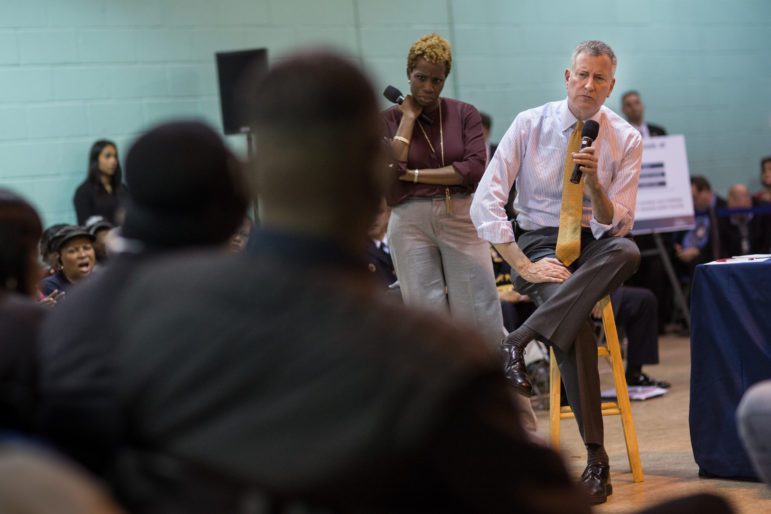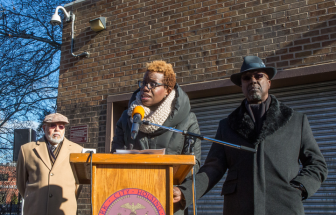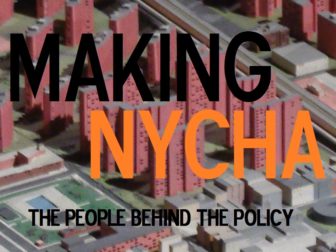
Michael Appleton/Mayoral Photography Office
Mayor Bill de Blasio and NYCHA Chair Shola Olatoye seen in January at a forum at the Wycoff Houses in Brooklyn. The authority says the private-sector partnerships it has embraced under Olatoye shore up finances and improve services to residents.
The New York City Housing Authority calls it the “partnership-based model.” Critics call it “privatization.” Inarguably, the housing authority increasingly relies on relationships with private donors, private developers and non-profit organizations to offer services and keep financially afloat.
The two most controversial NYCHA partnership models regularly make headlines: the authority’s plan to lease land to developers to build affordable and market-rate housing—known as infill development—and NYCHA’s conversion of public housing buildings to privately-managed project-based Section 8 buildings through the federal Rental Assistance Demonstration (RAD) program. But a number of other, lesser-known initiatives reveal the extent to which NYCHA is transitioning away from its historic role as a direct-service provider and assuming one of a “service coordinator.”
It has outsourced all but 15 of its 255 community centers and senior centers. It is working with a host of community-based organizations to boost residents’ economic success. And to fund this work, it has launched its own nonprofit, the Fund for Public Housing, which will urge foundations and former residents who’ve done well to support NYCHA’s expanding set of partnerships.
NYCHA’s turn to the private sphere is in part an effort to downsize in the face of its enormous fiscal crisis—a $17 billion capital repair backlog and an operating deficit of tens of millions of dollars each year. Yet NYCHA officials also believe the transition will expand opportunities for NYCHA residents. In Next Generation NYCHA, the 10-year strategic plan released last year, NYCHA said that while it “has remained steadfast about ensuring high-quality services to residents,” those efforts are hampered by unreliable funding streams, limited range in the scope of the services offered and poor communication with residents about what’s on offer and what’s in need.
The solution, NYCHA claims, is to harness the expertise of outsiders who can bring sector-specific skills and innovative thinking to shake up NYCHA’s way of doing business.
While some advocates and residents are hopeful about the abundance of new services, they simultaneously call for caution, noting that the private sector is not the answer to everything, and that engaging with external partners raises new questions, including how those partners will be held accountable to the residents of public housing.
“Why do we take for granted that private operation is inherently a better operation than public operation? I think sometimes it is. Sometimes it’s not. But we accept it as a given,” says councilmember Ritchie Torres, chair of the public housing committee.
“I believe in public-private partnerships,” Torres says, “but we have to be careful not to be too enamored with buzz words and assume that the public-private partnership in every case is the best option. We have to be wary of ideology.”
A gradual transformation
NYCHA has long partnered with nonprofit organizations and other city agencies to run community and senior centers, but prior to 2009 it operated a large portion of them on its own. The transition to a new model began under the Bloomberg administration, when NYCHA found itself increasingly unable to pay for resident services without diverting funds from capital repairs. In 2009, it cut staff at 200 community centers and closed 25 others, which were subsequently reopened by the Department of Youth and Community Development (DYCD). The authority transferred another 45 community centers and four senior centers to DYCD and the Department of Aging (DFTA) in 2013.
This gradual transition of NYCHA’s centers converged with the authority’s 2010 launch of the Office of Public and Private Partnerships and the 2012 release of Plan NYCHA, a five-year plan that Bloomberg called “an ambitious call to foster partnerships” with “nonprofit and private-sector organizations.” With each partnership, NYCHA sought to both relieve some of its own financial burden and enhance the scope of services provided to NYCHA residents.
For instance, under an initiative launched in 2012 called the “Zone model,” the authority’s Office of Resident Economic Empowerment & Sustainability (REES) divided the city’s housing developments into 15 geographic zones, cultivating “Zone partners” in each district that provide a web of services for NYCHA residents. The types of programming also expanded from a traditional menu of adult education and employment services to one-on-one financial counseling and the incubation of resident businesses and worker-owned cooperatives. Zone Partners are funded by a variety of sources, while NYCHA provides the “non-financial resources,” such as free space in NYCHA-owned buildings.
Mayor de Blasio has amped up many of these initiatives. While during his first year, the city provided $17.1 million to preserve NYCHA’s remaining 57 community and senior centers, the following year he transferred 42 of these centers to community-based organizations funded by DYCD and DFTA. The transfers of these centers to other agencies saved NYCHA $16 million dollars and, the authority claims, “better [ensures] high quality” of services for residents. In addition, the administration is in the process of transitioning its Family Services Department, which currently offers case-management, to a new, partnership-based model. It further aims to increase the number of residents employed through REES initiatives from 2,000 residents a year to 4,000 annually by 2025.
The ingredients of successful partnership
This transition from a direct service to a partnership-based approach has elicited a variety of reactions from NYCHA residents, with some excited for an expansion of programs, and still others frustrated with their perceived lack of control over the changes.
Charlene Nimmons, a former tenant association president at Wyckoff Houses who still lives at that development, says she is fairly satisfied with Goodwill NYNJ, which took over their community center last year.
“Here at Wyckoff I can’t say it’s much of a difference,” she says. “We were still involved and committed to making sure that it was…productive for our residents.” (Goodwill NYNJ will no longer run the community center next year, and NYCHA has released an RFP to find a new partner.)
Lisa Kenner, the tenant association president of Van Dyke I in Brownsville, was pleased with new job-training opportunities available through the Job-Plus program, a collaboration between community-based organizations, other city agencies, and REES. At the same time, however, she was frustrated that Van Dyke’s community center had been converted to a “Cornerstone Community Center” funded by DYCD and run by Medgar Evers College.
“They should have never given this center over,” says Kenner, who contends that the Medgar Evers staff does not communicate sufficiently with the tenant association executive board, did not include members of her executive board on the community center’s own advisory board, and did not give her executive board sufficient heads-up about the community center’s meetings or events.
“To me they are outsiders coming in,” she says. “When the New York City Housing Authority had it, we were always included.”
(All of the DYCD-funded Cornerstone community centers are required to have residents on their advisory board, including two members of the tenant resident association, though not necessarily the resident association’s executive board. Medgar Evers Community Center’s program director Saundra Johnson said their advisory board does include tenant association members, and that executive board members have been invited to attend all advisory board meetings this year and are invited by special invitation to all events. “We are always willing to improve on the work we do and this desire includes working more closely with the Van Dyke I Residents Association,” she said.)
Whatever the case at Van Dyke, Councilmember Torres recognizes that many residents were content with their NYCHA-run centers, and he questions whether turning them over to community-based organizations was a necessary step.
“The decision to privatize the operation of the community centers and the senior centers was based on ideology,” he says. “As far as I know there was no assessment of the performance of the centers. There was no engagement with the residents asking them if they were satisfied with their centers.”
Aixa Torres, tenant association president at Alfred E. Smith Houses in the Lower East Side, says that the success of a privately run community center depends on the activeness of the tenant association and the willingness of the nonprofit to act on the feedback of the TA and other residents.
“In terms of the services that are given to the residents, what influence do the residents have with the boards of [community-based organizations]?” she poses. “Do you give services that the residents really need, or do you give services because [you] think this is what they need?”
Affordable-housing advocates, recognizing the desire of public-housing residents to have a say in NYCHA’s new partnerships, have begun thinking about ways the city can provide more opportunities for tenant input. Damaris Reyes, executive director of the tenant advocacy organization Good Old Lower East Side (GOLES), says that the city might consider giving resident organizations decision-making power both in choosing outside partners and evaluating their work.
“I think there’s a recognition that these community centers and programming is a good thing. I think the process…of how we get to ‘who is in there’ and ‘what is done’ probably needs some serious fine-tuning,” Reyes says. “TA leaders feel like they have their finger on the pulse on what their residents need and want to be consulted about who is the nonprofit provider who comes there.”
The affordable housing and community development organization* Enterprise Community Partners is also thinking about how to ensure private partners are accountable to NYCHA residents. They are using a $500,000 grant from the Citi Foundation to fund a number of initiatives, including convening a group of public housing residents, NYCHA leaders and community-based organizations to create guidelines for developers participating in the RAD program.
The RAD program aims to shift some NYCHA developments from the underfinanced federal public housing subsidy to the more reliable Section 8 funding stream. NYCHA buildings involved in RAD are owned by an entity jointly controlled by the housing authority and a private developer, an arrangement that allows the partners to seek private investment to fund repairs. NYCHA’s first RAD program is being rolled out at Ocean Bay Apartments in the Rockaways; the authority eventually hopes to apply the program to the 15,000 units within its portfolio that are in the worst physical condition.
Enterprise aims to focus on those 15,000 units, which are spread throughout the city, and craft guidelines so that tenants have a say during RAD conversions and developers’ involvement leads to an increase in opportunities for residents. They also hope to provide NYCHA and developers with new tools to assess the needs of each public housing development and to connect residents to appropriate services.
NYCHA’s philanthropic arm
Besides bringing in private groups to deliver services and private companies to operate housing under RAD, NYCHA has also created its own private entity. Last year it launched a 501c3 called the Fund for Public Housing, its mission to raise money to provide new resident services, economic opportunities, and place-based improvements.
“While there is a fund for public health and a fund for public schools, this is the first kind of fund for public housing in the country,” says Rasmia Kirmani-Frye, founding president of the fund and director of NYCHA’s Office of Public and Private Partnerships. “I think in New York City we’re really bucking the national trend, which has really been to tear down public housing.”
Part of the challenge will be encouraging the public to view public housing as one of the city’s most vital assets—even one that can “spark innovation” through creative experimentation, as Kirmani-Frye puts it. In light of the fact that the Fund for Public Housing is nationally unprecedented, its goals are especially ambitious: to raise $200 million in only three years.
“It will definitely be a challenge,” says Scott Anderson, a fund board member and the president of design and technology at Intersection, a company that provides technology consulting to cities. “I think in a lot of ways it can sound like a shocking amount of money, certainly from a fundraising perspective, but its also intentionally high to call attention to how big the problem is.”
So far the Fund has received $100,000 from the Deutsche Bank Americas Foundation, which will be used to develop new design guidelines for buildings on NYCHA land. Capital One is investing $25,000 in a youth leadership program, and Jeffrey Levine, chairman of Douglaston Development and an alumnus of Linden Houses, is contributing $100,000 for scholarships to City College. Citi, a longtime NYCHA partner, has also announced it will contribute.
Revenues could support a variety of initiatives, including expanding programming with NYCHA’s Zone Partners. The board is especially interested in encouraging the creation of worker-owned cooperatives and in scaling up Food Business Pathways, a program that enables NYCHA residents to launch their own food businesses. Anderson envisions using the fund to enhance residents’ internet access and to launch a pilot program that would connect NYCHA’s facilities to a digital system that collects information about residents’ usage patterns, allowing NYCHA to reduce its environmental footprint and make its maintenance workforce more efficient.
The Fund for Public Housing is not a democratically elected entity, but Kirmani-Frye says she’s aware of the importance of ensuring residents maintain power over privately-funded initiatives that could effect their daily lives. She says part of the challenge of the fund’s work will be creating effective “feedback loops”—engagement processes that will ensure residents participate in program development. The board is also planning a launch event that will involve residents and send a clear message about how they can be involved in the fund’s work. And their bylaws mandate that two of the board members are NYCHA residents, including one resident between the ages of 18 and 25.
That seat is currently held by 24-year-old Diatre Padilla, who lives with his grandmother in the Bronx’s Soundview Houses. A recent graduate of Columbia in Urban Studies and currently executive assistant at the Architectural League of New York, Padilla says he is excited that the fund, because it does not face the same strictures as a public entity like NYCHA, will be able to experiment with new policy solutions. He says he is especially passionate about ground-up urban planning, and hopes to ensure the fund’s work is based not only on his perspective, but on thorough community engagement.
“People…do want to be involved. On the flip side I think you see that when people aren’t involved in the changes that occur in their homes, you see a lot of anger and a lot of animosity,” Padilla says. His grandmother sometimes feels that way, and that’s why he’s involved. “Her kind of jadedness [on] the prospect of it ever getting better was an incentive for me to try to effect some positive change.”
* The original version of this article incorrectly referred to Enterprise as an “affordable-housing developer.”











3 thoughts on “NYCHA Responds to Fiscal Crisis With Embrace of Private Sector”
Didn’t the NYCHA chair Shola Olatoye used to work at Enterprise? Where is the mention of that?
Pingback: NYCHA - Urban Omnibus
Pingback: NYCHA